A project of the Hudson River Estuary Program
Compiled by Tom Lake, Consulting Naturalist
Overview
This was a week of multiple highlights not the least of which was a new fish species for the Hudson River watershed (new to us; it had been there all along). “Missing” young-of-year river herring made an appearance (in part), and a rare insect was spotted giving heightened visibility to the backcountry of the watershed.
Highlight of the Week
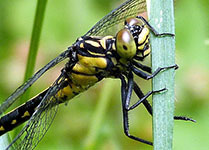 7/21 – Sullivan County, HRM 91: A rare southern pygmy clubtail dragonfly (Lanthus vernalis) was spotted in the Catskill Mountains near Rondout Reservoir. New York City Department of Environmental Protection field ecologist Frank Beres said that the dragonfly hopped on his finger and allowed him to take several photos before flying off. This species is considered critically imperiled in New York State and can only survive and reproduce in clear, clean waters, making them an indicator of water quality. The species’ population in New York and the Northeast has reportedly been dwindling for years. (Photo of southern pygmy clubtail dragonfly with permission from Project Noah) 7/21 – Sullivan County, HRM 91: A rare southern pygmy clubtail dragonfly (Lanthus vernalis) was spotted in the Catskill Mountains near Rondout Reservoir. New York City Department of Environmental Protection field ecologist Frank Beres said that the dragonfly hopped on his finger and allowed him to take several photos before flying off. This species is considered critically imperiled in New York State and can only survive and reproduce in clear, clean waters, making them an indicator of water quality. The species’ population in New York and the Northeast has reportedly been dwindling for years. (Photo of southern pygmy clubtail dragonfly with permission from Project Noah)
- NYSDEC
Natural History Entries
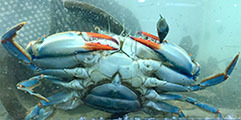 7/20 – Kowawese, HRM 59: It was a summer scorcher in many places in the mid-Hudson Valley as air temperatures touched 100 degrees Fahrenheit (F). On the beach, it was 99 degrees, and with no wind, it felt like 110 degrees (heat index). 7/20 – Kowawese, HRM 59: It was a summer scorcher in many places in the mid-Hudson Valley as air temperatures touched 100 degrees Fahrenheit (F). On the beach, it was 99 degrees, and with no wind, it felt like 110 degrees (heat index).
The inshore shallows had warmed to 84 degrees. Our catch included the local young-of-year fishes: spottail shiners (34-41 mm), striped bass (40-43 mm), and tessellated darters (22-24 mm). We caught several soft-shelled blue crabs and found a dozen or more blue crab moults just above the high tide line. Most seemed a few days old, and being just four days past the full moon, their presence was not a surprise. (Photo of blue crab courtesy of The River Project)
- Tom Lake, Phyllis Lake
[Note: one inch = 25.4 millimeters (mm)]
[As a crustacean, blue crabs have an exoskeleton (their skeleton is on the outside) and must moult periodically as they grow to accommodate their increasing internal body size. Blue crabs tend to moult more frequently around the full and new moons when the reach of tide is the greatest. These stronger and higher tides provide greater access to safer, shoreline tidemarsh niches. A shed exoskeleton, or moult, is a nearly exact replica of the crab except that when you open the carapace, you find it is empty – no one is home. It is not uncommon to receive reports of dead blue crabs (moults) on the beach around this time.
The new crab is now a softshell, noticeably larger, waiting for its new shell to harden, a process that can take up to twenty-four-hours depending on water temperature. Blue crabs have several colloquial names known mainly to crabbers. Adult males are called “Jimmys,” mature females are called “Sooks,” and immature females are known as “Sallys.” Tom Lake]
[June 2019 was the hottest June in 140 years, setting a global record. The average global temperature in June was 1.71 degrees F, above the 20th-century average of 59.9 degrees, and marked the 414th consecutive month in which temperatures were above the 20th-century average. National Oceanic and Atmospheric Administration (NOAA).]
7/20 – Bedford, HRM 35: The great blue heron rookery was now empty with all the nestlings having fledged. They finally took the leap of faith to leave their nests and were more comfortable down in the cooler water foraging on their own. My count this year was 13 occupied nests producing 24 nestlings. The winter storms took down some nest trees, and there were some nests in trees that were not used, likely because the nests were too small. They might be enlarged next year. In two years, these newly fledged herons will be sexually mature and will start their own families.
- Jim Steck
*** Fish of the Week ***
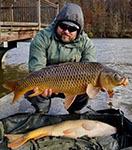 7/21 – Hudson River Watershed: Fish-of-the-Week for Week 32 is the common carp (Cyprinus carpio), number 39 (of 229) on our watershed list of fishes. If you would like a copy of our list, e-mail trlake7@aol.com. 7/21 – Hudson River Watershed: Fish-of-the-Week for Week 32 is the common carp (Cyprinus carpio), number 39 (of 229) on our watershed list of fishes. If you would like a copy of our list, e-mail trlake7@aol.com.
Common carp is a minnow, our largest of 34 minnows (Cyprindae) in the Hudson River watershed. They are native to Asia, having been introduced into North America from Europe in the Hudson River at Newburgh, Orange County, in 1831 (Boyle 1969). (Bill Greene and Sam Williams, our resident and expert carp anglers, bring these huge and powerful fish to life in their stories for the Almanac.)
One of my favorite carp stories also happens to be one of my favorite C. Lavett Smith stories (“Smitty” was the Curator of Fishes at the American Museum of Natural History). His story involved the Lake Champlain sea monster dubbed “Champ.” Champ was, and may still be, the lake’s version of the Loch Ness monster – the legend still has its adherents. In the late Pleistocene, Lake Champlain was known as the Champlain Sea, with beluga whales and an outlet to the North Atlantic.
Some of the most compelling “evidence” of Champ was a thirty-second video taken by a boater with a hand-held camcorder. It showed a long and broad series of undulating fin-like ripples with what could be construed as a “head” on one end and a “tail” on the other. Smitty took that video, slowed it down to study it, frame-by-frame, and after painstaking analyses, he concluded that it was just a very large congregation of spawning common carp, with the males leap-frogging over the females, creating the undulating illusion. (Photo of common carp courtesy of Sam Williams)
- Tom Lake
7/22 – Norrie Point, HRM 85: I stood on the riverside patio at Norrie Point Environmental Education Center this morning looking halfway across the river to Esopus Island. A great blue heron took off from rocks at the north end and headed for the east shore. About halfway across, it veered north, slowed, and extended its legs as if it were going to land, but there was nothing to land on. Instead, the heron simply set down in the water, folded its wings over its back, and sat there floating just as a gull would. It then stretched out its neck, picked up a fish that was floating on the surface and took off with no problem, flying to the east shore where it ate the fish. Immediately after swallowing, the heron waded into the shallows to continue hunting.
- David Lund
7/22 – Hudson Highlands State Park, HRM 55: We gathered up seven beach-goers and four dogs to join us in our exploration of the Hudson River at Little Stony Point. The ambiance of this place, coupled with a wonderful sandy beach, makes catching fish almost secondary. We were still in the hunt for the 2019 young-of-year class of river herring, but once again, found none. Our seine filled with young-of-year, but they were all striped bass, spottail shiner, and tessellated darters – all nice fish, but not what we were looking for. The river was 80 degrees F, and the measured salinity was about 1.0 parts-per-thousand (ppt).
- Tom Lake, Seth Dinitz, Elie Dinitz, Melanie Campanile
7/22 –Yonkers, HRM 18: Students from the Rockland Children’s Psychiatric Center joined the staff at the Sarah Lawrence Center for the Urban River at Beczak to go seining. It was the time of the summer when the numbers of Atlantic silverside (55-100 mm) begin to build, and they were our high catch today (33). The students also caught several blue crabs.
- Elisa Caref, Lucy Jurina, Marla Wilson, Janesse Bell, Zahir Foster.
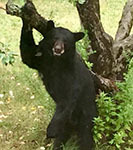 7/23 – Saugerties, HRM 102: I was surprised this morning to see a black bear, a young adult, possibly last year’s cub, under our apple tree. This was the first one I had seen this summer. I watched as the bear sprawled on its stomach in the grass eating apples. After a while, the bear got up, walked over to the apple tree, backed into a limb, and proceeded to get a back scratch. (Photo of black bear courtesy of Mary Alice Lindquist) 7/23 – Saugerties, HRM 102: I was surprised this morning to see a black bear, a young adult, possibly last year’s cub, under our apple tree. This was the first one I had seen this summer. I watched as the bear sprawled on its stomach in the grass eating apples. After a while, the bear got up, walked over to the apple tree, backed into a limb, and proceeded to get a back scratch. (Photo of black bear courtesy of Mary Alice Lindquist)
- Mary Alice Lindquist
 7/23 – Upper Bay, New York Harbor: We added species number 229 to our Hudson River Watershed list of fishes this week. It was a gray triggerfish (Balistes capriscus), captured in a licensed commercial fish pot well inside the Verrazano-Narrows, the demarcation line between the Upper and Lower Bays of New York Harbor. The gray triggerfish was about 14-inches-long, the maximum size for the species. (Photo of gray triggerfish courtesy of Peter Park) 7/23 – Upper Bay, New York Harbor: We added species number 229 to our Hudson River Watershed list of fishes this week. It was a gray triggerfish (Balistes capriscus), captured in a licensed commercial fish pot well inside the Verrazano-Narrows, the demarcation line between the Upper and Lower Bays of New York Harbor. The gray triggerfish was about 14-inches-long, the maximum size for the species. (Photo of gray triggerfish courtesy of Peter Park)
- Peter Park
[We have anticipated this species being in the lower estuary, especially the Upper Bay of New York Harbor. In the last few years, we have read accounts of gray triggerfish being taken by anglers from the Brooklyn waterfront, albeit with no photos to verify. The literature suggests that the gray triggerfish is at its northern extent in the New York Bight, being much more common to the south (e.g., Chesapeake Bay literature cites the species as a "sometimes summer visitor"). Tom Lake]
[On our fish list for the Hudson River Watershed, we have listed the gray triggerfish as a native species. “Native,” as opposed to “introduced,” is a theme we often discuss with students. That discussion provides context for the catches we make with our students and educators.
Our state fish, the brook trout, along with northern pike and lake trout, and a few others, are some of our first native species whose periglacial presence in the watershed dates to about 18,000 years ago. “Introduced” can range from intentional stockings such as brown and rainbow trout, largemouth and smallmouth bass, and walleye, to canal immigrants such as freshwater drum, gizzard shad, and channel catfish, to intentional invasive species like common carp, grass carp, and goldfish.
The benchmark for this bifurcation is the early 17th century. If a species was here when the first Europeans arrived, it was almost certainly native. Of the 229 species of fish documented for the Hudson River watershed, 178 are considered native (0.77).
With marine species like the gray triggerfish, we cannot assume to limit their distribution. Climate fluctuations in millennia past may have permitted boreal species from the north, as well as tropical species from the south, to stray into the New York Bight. Thus, we have to list them as native, at least potentially. Tom Lake]
7/24 – Beacon, HRM 61: There are days when optimum effort, such as seven hours on the water, will still not catch us a carp. Other than one large splash far out in the river early in the day, signs of carp activity were absent. Yet, I was content with seven small channel catfish (12-14-inches), caught, measured, and released, plus a 10-inch brown bullhead. The water temperature had climbed over 80 degrees F and that may have been affecting carp activity.
- Bill Greene
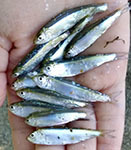 7/24 – Hudson Highlands State Park, HRM 55: A stiff, northwest wind buffeted the beach at Little Stony Point, and small patches of uprooted Eurasian water milfoil (Myriophyllum spicatum) floated in the chop. We planned on a long haul today. Not long in the sense of our seine (85-foot), but in our ongoing effort searching for young-of-year river herring. We had seen fewer than five all season, far fewer than we would have expected. Perhaps, without reason, we had high expectations. 7/24 – Hudson Highlands State Park, HRM 55: A stiff, northwest wind buffeted the beach at Little Stony Point, and small patches of uprooted Eurasian water milfoil (Myriophyllum spicatum) floated in the chop. We planned on a long haul today. Not long in the sense of our seine (85-foot), but in our ongoing effort searching for young-of-year river herring. We had seen fewer than five all season, far fewer than we would have expected. Perhaps, without reason, we had high expectations.
Our first dozen hauls in the last of the down tide netted only what we had been seeing for weeks: young-of-year striped bass (24-51 mm) and spottail shiners. But, not unlike “last cast” when angling, “last haul” sometimes produces magic as well. In hindsight, however, we think it was the change of the tide, the first of the flood, that made the difference.
Our last haul had fish spilling out of the net. We had caught an estimated 250 mixed herring. We took a representative sample to verify, but it seemed to us that 50% were blueback herring (40-52 mm), 45% were alewives (47-52 mm), and about 5% were Atlantic menhaden (49-51 mm). A real mixed bag! The river was 81 degrees F; salinity was there, but barely measurable. (Photo of river herring courtesy of Tom Lake)
- Tom Lake, T.R. Jackson, B.J. Jackson
[The irony within our young-of-year catch of fishes had not escaped us. We counted scores of blueback herring (Alosa aestivalis), many of which may have hatched in the Mohawk River far away to the northwest and hundreds of feet higher in elevation. In contrast, the Atlantic menhaden (Brevoortia tyrannus), a related saltwater herring, had hatched months ago in the Lower Bay of New York Harbor. These two herrings, born at least 200 miles apart, had taken long opposing journeys to be here on the same day at the northern gateway to the Hudson Highlands. Tom Lake]
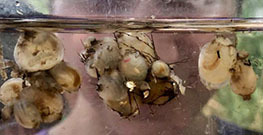 7/24 – Piermont, HRM 25: The river felt like bathwater with the temperature at 83 degrees F. The dissolved oxygen levels responded with a drop to 5.0 milligrams-per-liter (mg/L); salinity hovered around 5.5 ppt. Our catch was modest: our seine landed a white perch, an Atlantic silverside, and one small blue crab suggesting to us that the fish had headed to deeper, cooler water. We also netted numerous small clusters of tunicates that we identified as Molgula manhattansis. (Photo of tunicates courtesy of Margie Turrin) 7/24 – Piermont, HRM 25: The river felt like bathwater with the temperature at 83 degrees F. The dissolved oxygen levels responded with a drop to 5.0 milligrams-per-liter (mg/L); salinity hovered around 5.5 ppt. Our catch was modest: our seine landed a white perch, an Atlantic silverside, and one small blue crab suggesting to us that the fish had headed to deeper, cooler water. We also netted numerous small clusters of tunicates that we identified as Molgula manhattansis. (Photo of tunicates courtesy of Margie Turrin)
- Margie Turrin, Laurel Zaima,
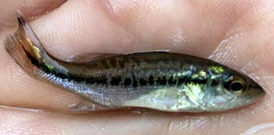 7/24 – Yonkers, HRM 18: Students from the Yonkers Educational Snapshots summer program joined the staff at the Sarah Lawrence Center for the Urban River at Beczak to help us seine the river. Atlantic silverside (a genuine symbol of summer in the lower estuary) were again high count with 25. We were very surprised to find, especially with the salinity at 6.0 ppt, four young-of-year largemouth bass (40-50 mm) in the net; this primarily freshwater fish is uncommon to rare at river mile 18. We also found our first moon jellyfish of the season in the net. (Photo of largemouth bass courtesy of Elisa Caref) 7/24 – Yonkers, HRM 18: Students from the Yonkers Educational Snapshots summer program joined the staff at the Sarah Lawrence Center for the Urban River at Beczak to help us seine the river. Atlantic silverside (a genuine symbol of summer in the lower estuary) were again high count with 25. We were very surprised to find, especially with the salinity at 6.0 ppt, four young-of-year largemouth bass (40-50 mm) in the net; this primarily freshwater fish is uncommon to rare at river mile 18. We also found our first moon jellyfish of the season in the net. (Photo of largemouth bass courtesy of Elisa Caref)
- Elisa Caref, Katie Lamboy, Marla Wilson, Jed Hoduilk.
[Young medusae (umbrella-shaped) moon jellyfish (Aurelia aurita) appear in the lower estuary in summer and early fall. They are true jellyfish, plankton feeders, with several hundred fringed tentacles that serve as sticky collectors of both phytoplankton and zooplankton. Adult moon jellyfish, with a pinkish rubbery umbrella up to ten-inches-across, are most commonly associated with ocean beaches. They are frequently stranded at the high-tide line and, while non-stinging, have startled many a beach walker who happened to step on one. Tom Lake]
7/24 – Manhattan, HRM 1: We checked our research sampling gear in Hudson River Park at The River Project's sampling station on the lighthouse tender Lilac at Pier 25 and caught a myriad of fishes and invertebrates. Among the fishes were four oyster toadfish (50-80 mm), two tautog (16, 21 mm), two white perch (235, 250 mm), and a little black sea bass (70 mm). Otherwise, we had blue crabs, both Jimmys and Sookies.
-Melissa Rex, Toland Kister
7/24 – Manhattan, New York City: Randall's Island Park Alliance staff and interns (Jack and Frayn) went seining on the island at both our Water's Edge site and our Little Hell Gate Salt Marsh site.
At Water’s Edge, in mid-morning, across three hauls at low tide, we netted 152 Atlantic silverside. The smallest of them was about 25 mm and as thin as a lollipop stick. The largest was nearly 100 mm and as thick as a bubble tea straw. Our prize catch at Water’s Edge was a (40 mm) northern kingfish (Menticirrhus saxatilis), a drum (Sciaenidae), with a head like a jelly bean. The water was 74 degrees F, and the salinity was 20.0 ppt.
At the Little Hell Gate Salt Marsh site in midday, across three hauls of our seine, we caught 40 killifish – woe in figuring out their species! In smaller numbers were young-of-year striped bass (50 mm) and bluefish (37-100 mm), as well as blue crabs and shore shrimp, some of which were gravid (with eggs), and 105 mud dog whelk snails. The water was 77 degrees F, and the salinity was 20.0 ppt.
- Jackie Wu.
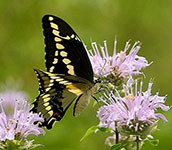 7/25 – Columbia County, HRM 113: Although we are generally unhappy with the number of butterflies that we are seeing this year, we were treated to a giant swallowtail feeding on a patch of Minarda (bee balm) in Hillsdale. (Photo of giant swallowtail courtesy of Deborah Tracy Kral) 7/25 – Columbia County, HRM 113: Although we are generally unhappy with the number of butterflies that we are seeing this year, we were treated to a giant swallowtail feeding on a patch of Minarda (bee balm) in Hillsdale. (Photo of giant swallowtail courtesy of Deborah Tracy Kral)
- Bob Schmidt, Kathy Schmidt
7/25 – Yonkers, HRM 18: The Westhab Community Camp joined the staff at the Sarah Lawrence Center for the Urban River at Beczak to help us seine the river. It was that time of the summer when the numbers of Atlantic silverside begin to build, and they were our high catch today (12). Our net also caught American eel, striped bass, blue crabs, and shore shrimp.
- Lucy Jurina, Marla Wilson, Janesse Bell, Zahir Foster, Michael Treus, Katie Lamboy
7/26 – Southern Dutchess County: I live on a small lake (less than five acres) that has a likewise small island in the middle (diameter less than 500 feet). This morning, we saw at least 16 green herons, including 10-12 young. Among them were two sets of very new fledglings and one fuzzy chick, so young that we were shocked it was out of the nest.
- Laura Facchin, Maha Katnani (Ralph T. Waterman Bird Cub)
7/26 – Kowawese, HRM 59: The beach at Kowawese Unique Area (Orange County Park) that has been known, historically, as very biologically diverse – 10 fish species in a day is not uncommon – has become quite monotypic this season. While species diversity was not evident – we caught only young-of-year striped bass (33-58 mm) – the species richness (the number of fishes of a species) was impressive. Each haul today netted us scores of striped bass but nothing else. The much heralded young-of-year river herring from two days ago had once again become illusive. The river was a toasty 84 degrees F.
- Tom Lake, Jake Schreiber, Kurt Schreiber
7/26 – Yonkers, HRM 18: Iona Prep Summer Camp joined the staff at the Sarah Lawrence Center for the Urban River at Beczak to help us sample the Hudson River for aquatic life. Many of our usual fishes were there, including American eel, Atlantic silverside, and banded killifish, along with blue crabs and shore shrimp. The real surprise, however, was the continuing catch (10) of young-of-year largemouth bass we caught.
- Katie Lamboy, Marla Wilson, Janesse Bell, Zahir Foste, Michael Treus, Jed Hoduilk
7/26 – Manhattan, HRM 1: We finished the week by checking our research sampling gear in Hudson River Park at The River Project's sampling station on the lighthouse tender Lilac at Pier 25 and encountered another huge haul: Two oyster toadfish (25, 65 mm), one tautog (270 mm), a beautiful lined seahorse (75 mm), and an adorable butterfish (25 mm). There were also four blue crabs, again both Jimmys and Sookies.
-Nina Hitchings, Melissa Rex
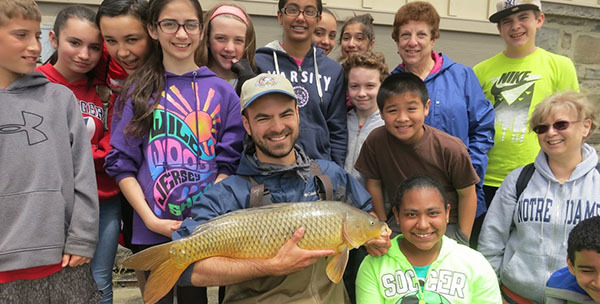
Summer 2019 Natural History Programs
Saturday, August 10 - 9:00am – 4:00pm
Great Hudson River Fish Count
Various sites
Join us for the Great Hudson River Estuary Fish Count on Saturday, August 10th to explore the amazing variety of slippery, wriggly, and fascinating creatures usually hidden below the river’s surface. The Fish Count will take place at 19 sites along the banks and piers of the Hudson from Staten Island in New York City to Peebles Island State Park in the Capital Region. Depending on the site, seines, minnow traps, and rods and reels are used. Participants may don waders to help haul a seine - a curtain of net used in shallow water - or try their luck with a fishing rod. After naturalists display and discuss the catch, the fish are released back to the river.
The Great Hudson River Estuary Fish Count is free. For details on sites, locations, and times, please visit DEC’s website. The event is sponsored by DEC’s Hudson River Estuary Program.
Tuesday, August 20 - Thursday August 22 (9:00 AM - 4:00 PM)
2019 Teachers on the Estuary and Living Environment Institute
Amazing Watersheds (22 credit hours for NYS certified teachers and administrators)
Five Rivers Environmental Education Center, 56 Game Farm Road, Delmar, New York
Join us this summer as we explore amazing watersheds. Teachers will spend three days gaining valuable knowledge and learning new curricula while using interdisciplinary approaches to explore watersheds. Some easy hiking on trails is involved.
Cost: $60.00 for materials, supplies, and refreshments (dinner provided on Wednesday)
To register, e-mail drew.hopkins@dec.ny.gov
Saturday, September 14 - 1:00- 4:00 PM
Science on the River
Norrie Point Environmental Education Center, Staatsburg
We would like to invite you to our open house featuring hands-on, interactive demonstrations, displaying scientific research and discovery on the estuary and in the Hudson Valley. Activities, with educational games and crafts, will be targeted towards both young and adult audiences.
For more information, email maija.niemisto@dec.ny.gov or call 845-889-4745 x109.
Saturday, September 21 - 10:00 AM
20th annual Hudson River Valley Ramble
Kowawese Unique Area, New Windsor (off Route 9W)
Join us on the beach at low tide as we investigate through sampling (with nets), Hudson River aquatic life in the shadow of Storm King Mountain at the northern gateway to the Hudson Highlands.
For more information, e-mail: trlake7@aol.com
Hudson River: Striped Bass Cooperative Angler Program
You can share your fishing trip information and help biologists understand and manage our Hudson River striped bass fishery.
Here’s how it works: Fill out a logbook provided by us whenever you fish on the Hudson River (by boat or from shore). Record general location, time, gear used, what you caught (or if you didn’t catch anything) and return the logbook when you are done fishing for the season. You’ll receive an annual newsletter summarizing the information in addition to the latest news regarding regulations and the river. Whether you catch-and-release or take home a keeper, you can be part of the Cooperative Angler Program.
Join today by contacting: jessica.best@dec.ny.gov, or call 845-256-3009
- Jessica Best
Hudson River Miles
The Hudson is measured north from Hudson River Mile 0 at the Battery at the southern tip of Manhattan. The George Washington Bridge is at HRM 12, the Tappan Zee 28, Bear Mountain 47, Beacon-Newburgh 62, Mid-Hudson 75, Kingston-Rhinecliff 95, Rip Van Winkle 114, and the Federal Dam at Troy, the head of tidewater, at 153. The tidal section of the Hudson constitutes a bit less than half the total distance – 315 miles – from Lake Tear of the Clouds to the Battery. Entries from points east and west in the watershed reference the corresponding river mile on the mainstem.
To Contribute Your Observations or to Subscribe
The Hudson River Almanac is compiled and edited by Tom Lake and emailed weekly by DEC's Hudson River Estuary Program. Share your observations by e-mailing them to trlake7@aol.com.
To subscribe to the Almanac (or to unsubscribe), use the links on DEC's Hudson River Almanacor DEC Delivers web pages.
Discover New York State Conservationist - the award-winning, advertisement-free magazine focusing on New York State's great outdoors and natural resources. Conservationist features stunning photography, informative articles and around-the-state coverage. Visit the Conservationist webpage for more information.
Useful Links
National Oceanic and Atmospheric Administration online tide and tidal current predictions are invaluable when planning Hudson River field trips.
For real-time information on Hudson River tides, weather and water conditions from sixteen monitoring stations, visit the Hudson River Environmental Conditions Observing System website.
DEC's Smartphone app for iPhone and Android is now available at: New York Fishing, Hunting & Wildlife App.
Adventure NY
Under Governor Cuomo's Adventure NY initiative, DEC is making strategic investments to expand access to healthy, active outdoor recreation, connect more New Yorkers and visitors to nature and the outdoors, protect natural resources, and boost local economies. This initiative will support the completion of more than 75 projects over the next three years, ranging from improvements to youth camps and environmental education centers to new boat launches, duck blinds, and hiking trails. Read more about the Adventure NY initiative. For more information on planning an outdoor adventure in New York State, visit DEC's website at http://www.dec.ny.gov/outdoor.
Information about the Hudson River Estuary Program is available on DEC's website at http://www.dec.ny.gov/lands/4920.html.
|


 7/21 – Sullivan County, HRM 91: A rare southern pygmy clubtail dragonfly (Lanthus vernalis) was spotted in the Catskill Mountains near Rondout Reservoir. New York City Department of Environmental Protection field ecologist Frank Beres said that the dragonfly hopped on his finger and allowed him to take several photos before flying off. This species is considered critically imperiled in New York State and can only survive and reproduce in clear, clean waters, making them an indicator of water quality. The species’ population in New York and the Northeast has reportedly been dwindling for years. (Photo of southern pygmy clubtail dragonfly with permission from Project Noah)
7/21 – Sullivan County, HRM 91: A rare southern pygmy clubtail dragonfly (Lanthus vernalis) was spotted in the Catskill Mountains near Rondout Reservoir. New York City Department of Environmental Protection field ecologist Frank Beres said that the dragonfly hopped on his finger and allowed him to take several photos before flying off. This species is considered critically imperiled in New York State and can only survive and reproduce in clear, clean waters, making them an indicator of water quality. The species’ population in New York and the Northeast has reportedly been dwindling for years. (Photo of southern pygmy clubtail dragonfly with permission from Project Noah) 7/20 – Kowawese, HRM 59: It was a summer scorcher in many places in the mid-Hudson Valley as air temperatures touched 100 degrees Fahrenheit (F). On the beach, it was 99 degrees, and with no wind, it felt like 110 degrees (heat index).
7/20 – Kowawese, HRM 59: It was a summer scorcher in many places in the mid-Hudson Valley as air temperatures touched 100 degrees Fahrenheit (F). On the beach, it was 99 degrees, and with no wind, it felt like 110 degrees (heat index). 7/21 – Hudson River Watershed: Fish-of-the-Week for Week 32 is the common carp (Cyprinus carpio), number 39 (of 229) on our watershed list of fishes. If you would like a copy of our list, e-mail
7/21 – Hudson River Watershed: Fish-of-the-Week for Week 32 is the common carp (Cyprinus carpio), number 39 (of 229) on our watershed list of fishes. If you would like a copy of our list, e-mail  7/23 – Saugerties, HRM 102: I was surprised this morning to see a black bear, a young adult, possibly last year’s cub, under our apple tree. This was the first one I had seen this summer. I watched as the bear sprawled on its stomach in the grass eating apples. After a while, the bear got up, walked over to the apple tree, backed into a limb, and proceeded to get a back scratch. (Photo of black bear courtesy of Mary Alice Lindquist)
7/23 – Saugerties, HRM 102: I was surprised this morning to see a black bear, a young adult, possibly last year’s cub, under our apple tree. This was the first one I had seen this summer. I watched as the bear sprawled on its stomach in the grass eating apples. After a while, the bear got up, walked over to the apple tree, backed into a limb, and proceeded to get a back scratch. (Photo of black bear courtesy of Mary Alice Lindquist) 7/23 – Upper Bay, New York Harbor: We added species number 229 to our Hudson River Watershed list of fishes this week. It was a gray triggerfish (Balistes capriscus), captured in a licensed commercial fish pot well inside the Verrazano-Narrows, the demarcation line between the Upper and Lower Bays of New York Harbor. The gray triggerfish was about 14-inches-long, the maximum size for the species. (Photo of gray triggerfish courtesy of Peter Park)
7/23 – Upper Bay, New York Harbor: We added species number 229 to our Hudson River Watershed list of fishes this week. It was a gray triggerfish (Balistes capriscus), captured in a licensed commercial fish pot well inside the Verrazano-Narrows, the demarcation line between the Upper and Lower Bays of New York Harbor. The gray triggerfish was about 14-inches-long, the maximum size for the species. (Photo of gray triggerfish courtesy of Peter Park) 7/24 – Hudson Highlands State Park, HRM 55: A stiff, northwest wind buffeted the beach at Little Stony Point, and small patches of uprooted Eurasian water milfoil (Myriophyllum spicatum) floated in the chop. We planned on a long haul today. Not long in the sense of our seine (85-foot), but in our ongoing effort searching for young-of-year river herring. We had seen fewer than five all season, far fewer than we would have expected. Perhaps, without reason, we had high expectations.
7/24 – Hudson Highlands State Park, HRM 55: A stiff, northwest wind buffeted the beach at Little Stony Point, and small patches of uprooted Eurasian water milfoil (Myriophyllum spicatum) floated in the chop. We planned on a long haul today. Not long in the sense of our seine (85-foot), but in our ongoing effort searching for young-of-year river herring. We had seen fewer than five all season, far fewer than we would have expected. Perhaps, without reason, we had high expectations. 7/24 – Piermont, HRM 25: The river felt like bathwater with the temperature at 83 degrees F. The dissolved oxygen levels responded with a drop to 5.0 milligrams-per-liter (mg/L); salinity hovered around 5.5 ppt. Our catch was modest: our seine landed a white perch, an Atlantic silverside, and one small blue crab suggesting to us that the fish had headed to deeper, cooler water. We also netted numerous small clusters of tunicates that we identified as Molgula manhattansis. (Photo of tunicates courtesy of Margie Turrin)
7/24 – Piermont, HRM 25: The river felt like bathwater with the temperature at 83 degrees F. The dissolved oxygen levels responded with a drop to 5.0 milligrams-per-liter (mg/L); salinity hovered around 5.5 ppt. Our catch was modest: our seine landed a white perch, an Atlantic silverside, and one small blue crab suggesting to us that the fish had headed to deeper, cooler water. We also netted numerous small clusters of tunicates that we identified as Molgula manhattansis. (Photo of tunicates courtesy of Margie Turrin) 7/24 – Yonkers, HRM 18: Students from the Yonkers Educational Snapshots summer program joined the staff at the Sarah Lawrence Center for the Urban River at Beczak to help us seine the river. Atlantic silverside (a genuine symbol of summer in the lower estuary) were again high count with 25. We were very surprised to find, especially with the salinity at 6.0 ppt, four young-of-year largemouth bass (40-50 mm) in the net; this primarily freshwater fish is uncommon to rare at river mile 18. We also found our first moon jellyfish of the season in the net. (Photo of largemouth bass courtesy of Elisa Caref)
7/24 – Yonkers, HRM 18: Students from the Yonkers Educational Snapshots summer program joined the staff at the Sarah Lawrence Center for the Urban River at Beczak to help us seine the river. Atlantic silverside (a genuine symbol of summer in the lower estuary) were again high count with 25. We were very surprised to find, especially with the salinity at 6.0 ppt, four young-of-year largemouth bass (40-50 mm) in the net; this primarily freshwater fish is uncommon to rare at river mile 18. We also found our first moon jellyfish of the season in the net. (Photo of largemouth bass courtesy of Elisa Caref) 7/25 – Columbia County, HRM 113: Although we are generally unhappy with the number of butterflies that we are seeing this year, we were treated to a giant swallowtail feeding on a patch of Minarda (bee balm) in Hillsdale. (Photo of giant swallowtail courtesy of Deborah Tracy Kral)
7/25 – Columbia County, HRM 113: Although we are generally unhappy with the number of butterflies that we are seeing this year, we were treated to a giant swallowtail feeding on a patch of Minarda (bee balm) in Hillsdale. (Photo of giant swallowtail courtesy of Deborah Tracy Kral)